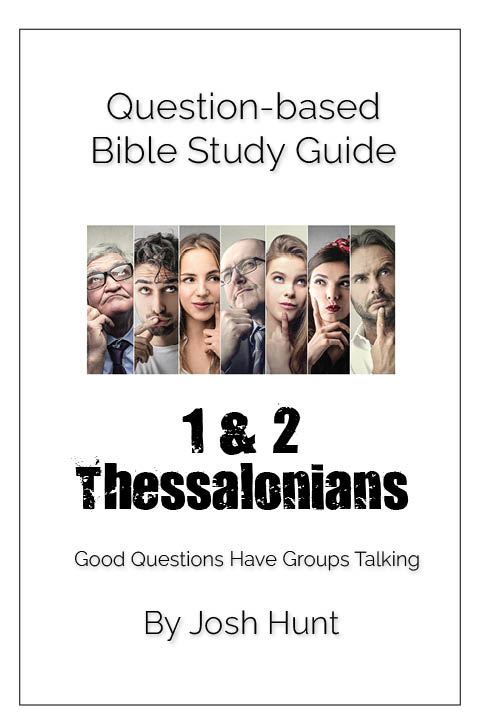1 – 2 Thessalonians Lesson #1 1 – 2 Thessalonians Lesson #2 1 – 2 Thessalonians Lesson #3 1 – 2 Thessalonians Lesson #4 1 – 2 Thessalonians Lesson #5 1 – 2 Thessalonians Lesson #6 1 – 2 Thessalonians Lesson #8 1 – 2 Thessalonians Lesson #9 1 – 2 Thessalonians Lesson #10 1 – 2 Thessalonians Lesson #11 1 – 2 Thessalonians Lesson #12 1 – 2 Thessalonians Lesson #13 “From you the word of the Lord has sounded forth, not only in Macedonia and Achaia, but also in every place. Your faith toward God has gone out, so that we do not need to say anything” (1 Thessalonians 1:8). One of the greatest joys the apostle Paul must have experienced was in witnessing those whom he discipled surpassing his expectations. Such was the case with the believers in Thessalonica. They were surviving—and thriving—under the worst conditions. In the midst of persecution and suffering, these believers were spreading the gospel so quickly and effectively that it was making Paul’s ministry unnecessary in certain places. Paul’s joy, excitement, and gratitude are evident throughout his letters to the Thessalonians. But his need to correct false teachings they had adopted—such as wrong beliefs about Jesus’ return—is also evident in his words. Paul’s letters thus serve as an encouragement for the believers in Thessalonica—and for us—to keep sharing the gospel … but to do so with sound doctrine. 1 THESSALONIANS Author and DateThe author of this letter identifies himself as Paul (see 1:1), and his opening words indicate that he wrote it alongside two close associates: Timothy (his coworker) and Silvanus (also known as Silas). The epistle contains a number of details about Paul’s life that fit with what we know of him based on his other letters and the book of Acts—particularly the events of Paul’s experience in Thessalonica as recorded in Acts 17:1–9. The early Muratorian Canon (c. AD 180) listed the epistle as among Paul’s works, and early church leaders such as Irenaeus (c. AD 185), Tertullian (c. AD 210), and Clement of Alexandria (c. AD 198) all acknowledged it was authored by the apostle. It is likely Paul wrote 1 Thessalonians during his stay in Corinth, c. AD 50. Background and SettingPaul arrived in Thessalonica during his second missionary journey, c. AD 49–50, and likely ministered in the city for several months. Luke records he was accompanied by Silas, and they began preaching the gospel in the Jewish synagogue, “explaining and demonstrating that the Christ had to suffer and rise again from the dead” (Acts 17:3). The message resonated with a few Jewish men, many devout Greeks (Gentiles), and some of the leading women in the city. Unfortunately, this triggered an angry reaction among the Thessalonian Jews, and ultimately they formed a mob and drove the men from the city. The two escaped to Berea, but were also forced to flee that city when the mob followed them. Paul eventually made his way to Corinth, where he sent his coworker Timothy to check on the believers in Thessalonica. The report Paul received back gladdened his heart, prompting him to write his first letter to express his joy and thankfulness that the community was thriving in spite of persecution. Paul also took the opportunity to defend himself against certain false accusations, explain why he had not yet returned to the city himself, and correct some doctrinal errors that had surfaced. Key ThemesSeveral key themes are prominent in Paul’s first letter to the Thessalonians. The first is that believers in Christ must persevere in their faith. The believers in Thessalonica were facing persecution for their decision to follow Christ as their Savior. Paul is concerned they might turn away from the message of the gospel in the midst of that pressure, so he expresses his thankfulness for them and encourages them to keep “setting the example” for others in their faith. Paul wants them to know he has not forgotten about them. In fact, he longs to be with them again so he can help them to mature spiritually (see 1 Thessalonians 1:1–10; 2:17–20). A second theme is that followers of Christ must remember their high calling. Paul’s opponents in Thessalonica were calling his conduct into question, and he was concerned these attacks might cause some to question the gospel he was proclaiming. So, Paul defends himself by explaining his true motives and the work God has for him to do (see 2:1–12). In the process, he reminds the believers of their high calling from God and urges them to pursue lives of holiness, extend brotherly love to one another, and continue making God-honoring choices in their lives (see 4:1–12). A third theme is that believers in Jesus can look forward to the return of Christ. In Paul’s absence, the believers in Thessalonica were raising questions about the return of Christ into this world. This appears to have been prompted by the fact that many in the congregation had died—and they were concerned that these believers would “miss out” and not participate in the resurrection. Paul encourages them by stating that these believers who have “fallen asleep” will actually rise first and be caught up with those who are still living. In this way, they can—and should—look forward with hope to this coming future event (see 4:13–5:11). David Jeremiah, 1 & 2 Thessalonians: The Call to a Holy Life, Jeremiah Bible Study Series (Nashville, TN: Thomas Nelson, 2020), v–vii. |




















